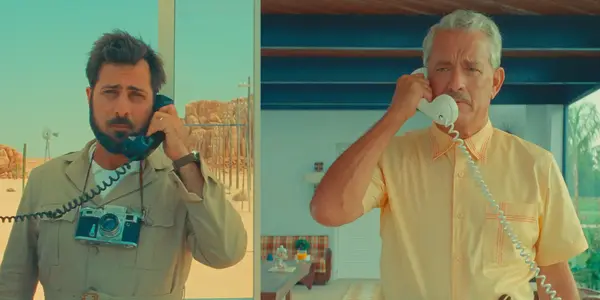Wes Anderson is much younger than Martin Scorsese and Steven Spielberg, yet he has made his ultimate fully confessional film already. Asteroid City is stylistically undifferentiated from most of Anderson’s recent output but it does do one thing different – it literally takes the audience behind the curtain of what makes him tick and what makes him very angry and what makes him love what he does.
Filming in a framing device and meta-textual structure that interlays the production as well as the exhibition of a stage play about a Junior Stargazer convention that is greeted by an alien’s visit, Anderson tears down any guess-work on what his processes are, how he navigates the familial and love relationships between his characters, his sets, and his ideas about movies.
Setting the Stage
The integral design of the movie, the jarring juxtapositions between the black-and-white of the stage production backdrops and the sun-bleached pastel colors of Asteroid City, is aimed at creating a distinct understanding of how two stories, those of conception and discovery, of acting and performing, of creating art and living it, combine.

The two-dimensionality of the production is stretched to three dimensions within Asteroid City. Despite Anderson’s rigid conformity to lateral movements once more, he actually explores his setting unabashedly in three dimensions from the get-go here, swerving the camera to all the landmarks to set the stage with narration before getting into it.
Impressive Tapestries
It’s important to note that the children in the film, who are ostensibly the main characters of ‘Asteroid City’, hardly feature at all outside of the stage-play’s confines. The also sets a dichotomy between production and play that outlines the ways in which fiction and non-fiction differentiate, and the ways in which Anderson’s imagination melds and forms a symbiotic relationship with the ‘real’ emotions and feelings he distills into his characters. The motives are well-intentioned and the tapestries of his production, always a high-point, are fun to look at and excavate all the details of, but the fundamental thing I can’t totally get with in Wes Anderson films is the way the characters talk and act.
Conclusion
A friend of mine asked me recently why I can consider Yorgos Lanthimos’s affected dialogue and direction for his actors to be fascinating and linguistically interesting but Wes Anderson’s affected style and language to be irritating. My initial response was just “well, that’s how my brain works I guess.” If I had to explain, I think it’s generally because I trend towards appreciating awkwardness and peculiarity in language that has sharp edges and a proclivity for being assaulting towards normal human connection.
It’s not that Wes Anderson doesn’t have anything interesting to say, he clearly does, and his latest two films The French Dispatch and Asteroid City have sequences of very clear emotionally empathetic revelations within them, but they’re always surrounded with wordy linguistic gymnastics that are cutesy and insufferably elongated – run-ons and parentheticals. It’s a writing style and a communication style that is just laborious to listen to. All in all, I’m willing to say I didn’t mind Asteroid City that much even if it’s not exactly going to stick with me.
Have you seen Asteroid City? what did you think? Let us know in the comments below!
Asteroid City was released nationwide in the US theaters on June 16, 2023!
Does content like this matter to you?
Become a Member and support film journalism. Unlock access to all of Film Inquiry`s great articles. Join a community of like-minded readers who are passionate about cinema - get access to our private members Network, give back to independent filmmakers, and more.